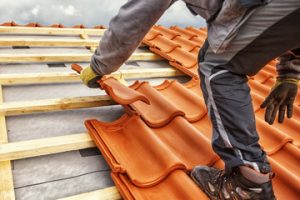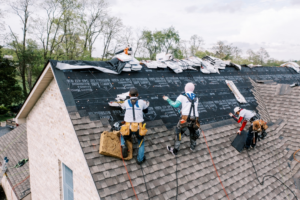Detecting and addressing roofing problems early can prevent leaks, extend the lifespan of the roof and reduce energy costs. Additionally, many insurance policies and warranties require regular inspections to remain valid.

Roof inspectors assess everything from shingles to gutters and flashing during a roofing inspection. They look for rust, gaps and cracks, and even fungus and moss. Visit https://arthursconstructionnc.com/ to learn more.
When it comes to roofing materials, the roof deck—or sheathing—is just as important as the shingles or tiles. The roof deck is the underlying layer that supports everything else on top of it, and any issues here can cause problems elsewhere. During a roofing inspection, estimators take special care to look at the roof deck and note any areas of damage or wear.
The next layer is the shingle or tile surface itself, which can be made from a variety of materials including asphalt shingles, clay tiles, concrete tiles, and flat single-ply membranes like EPDM and TPO. Each type of roofing material has its own advantages and disadvantages. For instance, asphalt shingles are relatively inexpensive and come in a wide range of colors and styles to fit any architectural style. However, they tend to have a shorter lifespan and are prone to wind damage and algae growth.
Another common roofing material is metal, which can be a durable and low-maintenance option. However, it requires a sturdy roof structure to support its weight and is vulnerable to corrosion. During a roofing inspection, inspectors will check that the existing roof is structurally sound and can handle the weight of a new metal roof.
Finally, there are other types of roofing material, such as slate or clay tiles, which offer a more classic and elegant look but can be quite expensive. During an inspection, experts will check the existing roof to see if it can handle the weight of such a heavy tile roof and will examine the interior ceilings for signs of water damage that could indicate leaks.
During an inspection, roofers also pay close attention to the vents and gutters on the building to ensure that they are properly sealed and draining. Clogged or improperly working vents can lead to moisture intrusion, which can lead to the growth of mold and other harmful organisms that can compromise the structural integrity of the roof and create health hazards for building occupants.
Flashing
Flashing is a type of metal trim that seals joints and helps prevent water leaks around various openings on a roof. It usually appears as a thin strip of metal that is typically sealed with caulk or other materials that are weather resistant. Flashing can be made of aluminum, copper, or other metals. It’s usually layered with shingles and is a common element in roof repairs.
During a roofing inspection, the inspector will look for damaged or missing flashing. Leaking or faulty flashing can allow water to seep into the roof, and the resulting water damage can lead to structural problems and mold or fungus growth in the attic. The inspector also checks gutters, downspouts, and vents to ensure that they are free of blockages or debris. The inspector will also check the eaves for proper ventilation, since moisture buildup in the eaves can cause rot or mold.
There are many different types of flashing, but they all serve the same purpose: to prevent water penetration and protect the integrity of the roof. Typical flashing is found at points of intersection between the roof and vertical walls, around fixtures like chimneys and skylights, and at the eaves of a dormer.
Some examples of flashing include sill flashing (used under doors and windows to prevent water from entering the wall), through-wall flashing (used to waterproof pipes, supports, cables, and other roof penetrations), cap flashing (used above doors and windows), and kickout flashing (used at the bottom of a wall or roof intersection to deflect water).
It’s important for home inspectors to understand how to recognize improper flashing conditions, because they are sometimes hidden behind the roof-covering material. The InterNACHI series “Mastering Roof Inspections” can help inspectors and other professional understand how to spot flashing conditions that require attention or repair.
Accessories
A professional roof inspector carries several tools to assess the overall condition of your roof, including a ladder that’s tall enough to access the roof and has non-slip feet. They also wear a hard hat to protect themselves from falling debris and other safety hazards while working on the roof. In addition, they bring a clipboard and notepad to record their observations and measurements. Other accessories that they may use include a flashlight, binoculars, and a chalk line to mark damaged areas on the roof.
Aside from examining the roof, roofing professionals will also check the exterior of your home or building for signs of water damage. For example, they might look for swollen skirting boards, soft spots on walls or ceilings, or blisters in wall paint that may indicate prolonged exposure to moisture. These issues should be addressed quickly to prevent further water damage and potentially costly repairs.
During the inspection process, roofing professionals will also check the gutters and downspouts to make sure they’re properly draining water and directing it away from the structure. They’ll also examine the roof drainage patterns to ensure they’re efficient, which can help reduce heating and cooling costs. They’ll also check the attic to see if there’s any water leakage or condensation problems that need to be addressed.
Infrared scanners are also a popular tool used by professional roof inspectors to identify hidden water damage in the attic or under the roof materials. These tools are especially useful in spotting leaks around chimneys, vents and other rooftop penetrations. They also come in handy for identifying thermal insulation problems that can lead to energy inefficiencies or structural issues.
Professional roof inspections can spot a wide variety of issues, including deteriorating shingles, loose flashing, and leaks. Detecting these problems early can save homeowners money on repairs and maintenance, as well as extend the lifespan of their roofing materials. Moreover, many insurance policies and roofing warranties require regular inspections to keep them valid. Having a documented history of inspections and maintenance can also increase the value of a home or commercial property and prove that the owner has a strong commitment to proper roofing upkeep.
Structural Integrity
The structural integrity of a structure depends on its ability to meet its intended load capacity under normal conditions and in the case of an emergency. Structural engineers consider many factors to achieve this, including material properties and design specifications, construction techniques and environmental impacts, but the main goal is to ensure that all components seamlessly connect together. This is known as structural integrity, and it requires a comprehensive inspection to reveal any potential issues before they cause damage or failure to the structure itself.
The first step in assessing structural integrity is to conduct a visual inspection. Qualified engineers or inspectors will examine a building’s exterior and interior, looking for signs of damage or deterioration, such as cracking, corrosion or deformation. They will also check that all connections are in good condition and that joints are not cracked or weakened.
If any defects are discovered, the engineer or inspector will recommend further testing or investigation of the structure’s condition. This may involve conducting a non-destructive test or performing a brittle fracture assessment, both of which can help to pinpoint any weaknesses in the structure.
During the inspection, an engineer will also examine the shingles, checking for signs of wear and tear and examining the fasteners that hold them in place to make sure they are securely attached. They will look for loose shingles, which can lead to leaks and further damage to the roof. They will also inspect the flashing – the metal pieces that seal intersections and protrusions in the roof to prevent water intrusion – for rust or breakage. They will also check the gutters and drainage system to make sure that they are free of blockages or debris, which can prevent proper functioning and allow water to seep under the roofing material.
A thorough and regular structural inspection can protect the integrity of a home or business, saving owners money in maintenance costs and repairs in the long run. It is essential that homeowners and businesses prepare for a structural inspection by removing any objects that could fall on the roof, making sure pets and children are kept away from the area and taking down any ladders or extensions. Moreover, it is helpful to have a list of specific concerns so that the inspector can focus on those areas.
